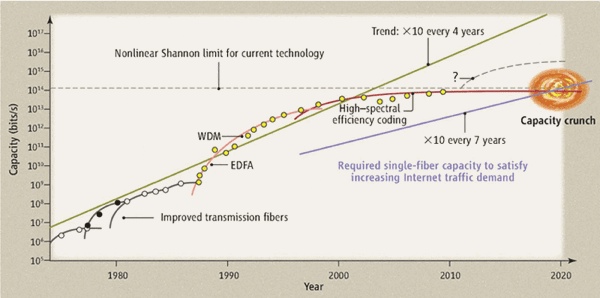From this week’s issue of Science comes Filling the Light Pipe by David J. Richardson. This is an important article highlighting a serious challenge facing the both the scientific and policy community.
From the abstract: “It has been a landmark year for the field of optical telecommunications, with the award of the 2009 Nobel Prize to Charles Kao for his insight in the mid-1960s that the future of communications lay in single-mode silica-based optical fibers (1) as well as the 50th anniversary of the first demonstration of the laser—both key technologies responsible for the development of the global-scale communications networks of today (2). Recently, however, a growing realization has emerged within the telecommunications industry that the end of the phenomenal growth in optical fiber communication capacity is within sight. At this year’s Optical Fiber Communication Conference (OFC 2010), several groups reported results within a factor of  2 of the ultimate capacity limits of existing optical fiber technology. Without radical innovation in our physical network infrastructure—that is, improvements in the key physical properties of transmission fibers and the optical amplifiers that we rely on to transmit data over long distances—we face what has been widely referred to as a “capacity crunch” that could severely constrain future Internet growth, as well as having social and political ramifications.”
2 of the ultimate capacity limits of existing optical fiber technology. Without radical innovation in our physical network infrastructure—that is, improvements in the key physical properties of transmission fibers and the optical amplifiers that we rely on to transmit data over long distances—we face what has been widely referred to as a “capacity crunch” that could severely constrain future Internet growth, as well as having social and political ramifications.”
[HT to Paul Kedrosky]


It’s all well and good to push the peak bandwidth out. For my money, however, the more interesting problem is how to get fiber to the home at an affordable rate. The multiple orders of magnitude difference between CATV/RJ45 and fiber are more important for the next ten years than the single order of magnitude shown above.